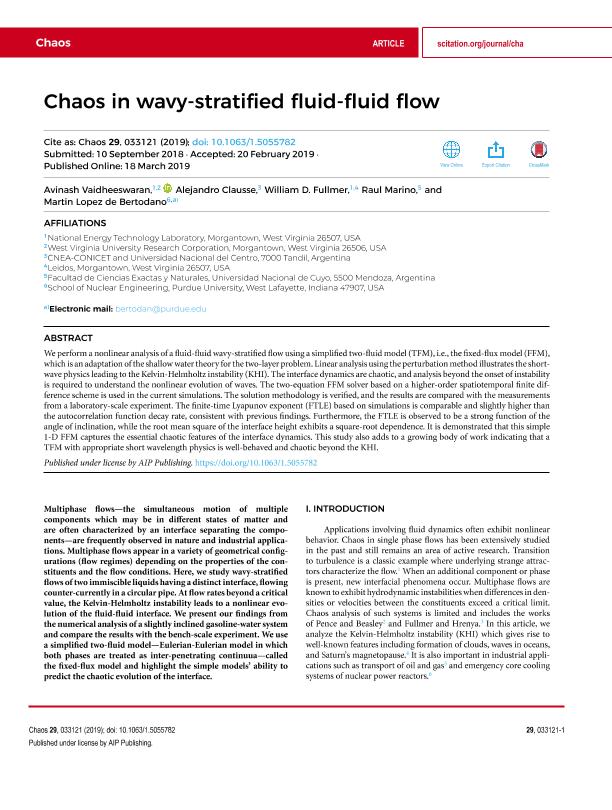Mostrar el registro sencillo del ítem
dc.contributor.author
Vaidheeswaran, Avinash
dc.contributor.author
Clausse, Alejandro

dc.contributor.author
Fullmer, William D.
dc.contributor.author
Marino, Raúl
dc.contributor.author
López de Bertodano, Martín
dc.date.available
2020-12-02T12:50:42Z
dc.date.issued
2019-03
dc.identifier.citation
Vaidheeswaran, Avinash; Clausse, Alejandro; Fullmer, William D.; Marino, Raúl; López de Bertodano, Martín; Chaos in wavy-stratified fluid-fluid flow; American Institute of Physics; Chaos; 29; 3; 3-2019; 1-7
dc.identifier.issn
1054-1500
dc.identifier.uri
http://hdl.handle.net/11336/119553
dc.description.abstract
We perform a nonlinear analysis of a fluid-fluid wavy-stratified flow using a simplified two-fluid model (TFM), i.e., the fixed-flux model (FFM), which is an adaptation of the shallow water theory for the two-layer problem. Linear analysis using the perturbation method illustrates the short-wave physics leading to the Kelvin-Helmholtz instability (KHI). The interface dynamics are chaotic, and analysis beyond the onset of instability is required to understand the nonlinear evolution of waves. The two-equation FFM solver based on a higher-order spatiotemporal finite difference scheme is used in the current simulations. The solution methodology is verified, and the results are compared with the measurements from a laboratory-scale experiment. The finite-time Lyapunov exponent (FTLE) based on simulations is comparable and slightly higher than the autocorrelation function decay rate, consistent with previous findings. Furthermore, the FTLE is observed to be a strong function of the angle of inclination, while the root mean square of the interface height exhibits a square-root dependence. It is demonstrated that this simple 1-D FFM captures the essential chaotic features of the interface dynamics. This study also adds to a growing body of work indicating that a TFM with appropriate short wavelength physics is well-behaved and chaotic beyond the KHI.
dc.format
application/pdf
dc.language.iso
eng
dc.publisher
American Institute of Physics

dc.rights
info:eu-repo/semantics/openAccess
dc.rights.uri
https://creativecommons.org/licenses/by-nc-sa/2.5/ar/
dc.subject
TWO-PHASE FLOW
dc.subject
STARTIFIED FLOW
dc.subject
LYAPUNOV EXPONENT
dc.subject
CORRELATION
dc.subject.classification
Ingeniería Nuclear

dc.subject.classification
Ingeniería Mecánica

dc.subject.classification
INGENIERÍAS Y TECNOLOGÍAS

dc.title
Chaos in wavy-stratified fluid-fluid flow
dc.type
info:eu-repo/semantics/article
dc.type
info:ar-repo/semantics/artículo
dc.type
info:eu-repo/semantics/publishedVersion
dc.date.updated
2020-11-18T21:23:04Z
dc.journal.volume
29
dc.journal.number
3
dc.journal.pagination
1-7
dc.journal.pais
Estados Unidos

dc.journal.ciudad
Melville
dc.description.fil
Fil: Vaidheeswaran, Avinash. National Energy Technology Laboratory; Estados Unidos. West Virginia University Research Corporation; Estados Unidos
dc.description.fil
Fil: Clausse, Alejandro. Universidad Nacional del Centro de la Provincia de Buenos Aires. Facultad de Ciencias Exactas. Grupo de Plasmas Densos Magnetizados. Provincia de Buenos Aires. Gobernación. Comision de Investigaciones Científicas. Grupo de Plasmas Densos Magnetizados; Argentina. Consejo Nacional de Investigaciones Científicas y Técnicas. Centro Científico Tecnológico Conicet - Tandil; Argentina
dc.description.fil
Fil: Fullmer, William D.. National Energy Technology Laboratory; Estados Unidos. Leidos; Estados Unidos
dc.description.fil
Fil: Marino, Raúl. Universidad Nacional de Cuyo. Facultad de Ciencias Exactas y Naturales; Argentina
dc.description.fil
Fil: López de Bertodano, Martín. Purdue University. School Of Nuclear Engineering; Estados Unidos
dc.journal.title
Chaos

dc.relation.alternativeid
info:eu-repo/semantics/altIdentifier/url/http://aip.scitation.org/doi/10.1063/1.5055782
dc.relation.alternativeid
info:eu-repo/semantics/altIdentifier/doi/http://dx.doi.org/10.1063/1.5055782
Archivos asociados
